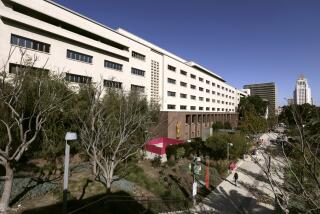Demolition begins at Phonehenge West
- Share via
Workers began demolishing the largest of the ornate maze of structures dubbed Phonehenge West in Acton on Friday, and a judge suggested that the eccentric builder who erected the complex may be forced to perform community service for violating building codes.
Alan Kimble Fahey, a retired phone company technician, was briefly jailed for allegedly resisting orders to tear down the complex and faced more time behind bars, but Los Angeles County Superior Court Judge Daviann L. Mitchell said Friday that his recent compliance may allow him to receive the more lenient sentence.
Fahey said he didn’t mind doing community service but said he felt like he was being persecuted.
“They’re spending hundreds of thousands of dollars to crush me. Why is that?” asked Fahey, 59, who spent almost three decades building his creation from discarded utility poles and other recycled materials. “Why are they trying to destroy a retired phone guy?”
Fahey was convicted in June of a dozen building code violations. He was scheduled to be sentenced last month but the proceedings were delayed after he suffered kidney stones. At Friday’s hearing in the Antelope Valley, sentencing was again postponed until Sept 23.
By then, the judge believes, Fahey should have complied with her orders — and Phonehenge West will be history, said Jerry Lennon, Fahey’s lawyer. Lennon estimated that his client would probably perform about 100 hours of community service and would probably have to pay a substantial sum in restitution and court fees.
Fahey’s case garnered a groundswell of support from people who share the view that Los Angeles County’s code enforcement regulations are excessive, and Friday’s hearing was attended by sympathizers.
“There seems to be some kind of glee on the part of the county when they literally destroy 30 years of a dream,” said Bill Guild, president of the Town Council in Littlerock, not far from Fahey’s Acton property. “Rather than working with him, they worked against him.”
County code enforcement officers argued that Fahey’s creation wasn’t structurally sound and presented fire and earthquake risks.
Fahey had been living in a barn on the property along with his wife, Pat, and 16-year-old son Leo.
Friends helped pack more than 20,000 books and a mountain of curios that Fahey planned to put in a museum, library and gift shop, his wife said. Other acquaintances adopted the Faheys’ chickens and turkeys.
The family moved to Tehachapi, where Fahey has leased an old farmhouse from a friend. Many of his former Phonehenge tenants, now homeless, sleep on his living room floor.
Richard Mello, who for two years occupied a trailer that Fahey had painted to look like a rail car, said he now lives part-time in a tent on Fahey’s Tehachapi property.
“I used to have a clean and nice place to live,” said Mello, 53. “Now I have no place. It’s been tough.”
On Friday, Fahey’s son Noah and his friend Josh Lederer salvaged copper wiring, steel and an old turbine rotary engine. They playfully threw rocks at the remaining window panes, hooting as they hit their targets.
“What does it matter now?” Noah Fahey, 26, asked as he recalled his father’s painstaking efforts to erect Phonehenge West.
Then the company Fahey hired to dismantle Phonehenge West went to work, pushing over a 70-foot tower — the highlight of his life’s labor.
Broken glass crunched under the tread of the heavy machinery. Banging and clanging shattered the silence as metal beams clashed. Friends and relatives, some with children, watched as the claws of cranes clutched at the wooden utility poles.
Fahey did not attend the demolition; family members said he didn’t want to see it.
But he remained defiant. One day he would rebuild Phonehenge West, he said after the hearing, and it would be “even better.”
“They’ve hammered me down as far as being a beacon of hope,” he said. But “they haven’t broken me.”
PHOTOS: Phonehenge West, habitable structure in Action
More to Read
Sign up for Essential California
The most important California stories and recommendations in your inbox every morning.
You may occasionally receive promotional content from the Los Angeles Times.














